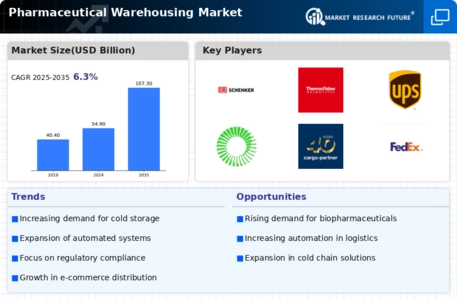By region, the study segments the market into North America, Europe, Asia-Pacific, and the rest of the world. In North America, the pharmaceutical warehousing market held the largest market share in 2022 due to the increasing need for pharmaceutical products. As per the IQVIA (US) 2022 report, new pharmaceutical medicine sales were up 67.7% in the US during the 2016–2021 period. In addition, the rising incidences of chronic diseases, including cancer, obesity, diabetes, and cardiac diseases, are raising the demand for pharmaceutical products in hospitals & clinics.
According to the American Heart Association, cardiovascular diseases (CVD) are the leading cause of death among the US population and accounted for 928,741 deaths in 2020.
Hence, the rising demand for pharmaceutical products and increasing incidences of chronic diseases are fueling segment growth in the North American pharmaceutical warehousing market.
Further, the major countries studied are: The US, Canada, France, Germany, the UK, Italy, Spain, China, Japan, India, Australia, South Korea, and Brazil.
FIGURE 3: PHARMACEUTICAL WAREHOUSING MARKET, BY REGION, 2022 & 2032 (USD BILLION)
The European pharmaceutical warehousing market accounted for the second-largest market share due to increasing launch of pharma warehouses. For instance, in September 2020, Maersk Line (Denmark) launched pharmaceutical warehouse in Poland which is fully compliant with European Good Distribution Practice and has carbon neutral facility to meet increased customer needs. Moreover, the European Commission 2020 report on Pharmaceutical Strategy for Europe revealed that expenditure on medicines in hospital settings accounted for 20% to 30% of hospital expenditure and is growing rapidly.
Furthermore, the France pharmaceutical warehousing market held the largest market in 2022, and the UK pharmaceutical warehousing market is projected to be the fastest-growing market in the Europe region.
The Asia-Pacific pharmaceutical warehousing market is the fastest-growing region from 2023 to 2032, owing to the launch of pharmaceutical warehouse services and the rising geriatric population in the region. For instance, in March 2023, Cargo-partner (Austria) launched the Pharma Competence Center in Shanghai, China, to meet the demand of customers in the increasingly important consumer market in China for pharmaceuticals and healthcare products. Furthermore, as per the Asia-Pacific Report on Population Ageing 2022, there were approximately 672 million people aged 60 or older in Asia-Pacific in 2022; further 886 million and 1,340 million will be in 2030 and 2050, respectively.
The growing geriatric population is increasing the demand of pharmaceutical products in hospitals & clinics. Moreover, the China pharmaceutical warehousing market accounted for the largest market share in 2022, and the India pharmaceutical warehousing market is projected to be the fastest-growing market in the Asia-Pacific region.



















Leave a Comment